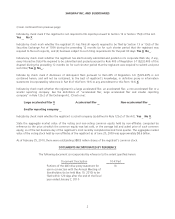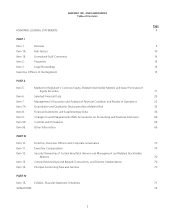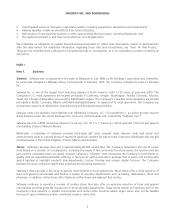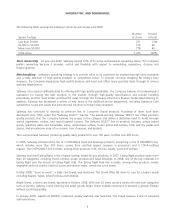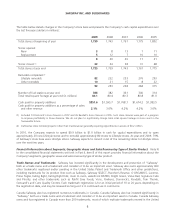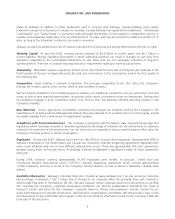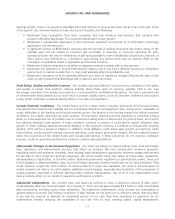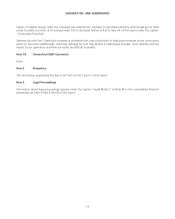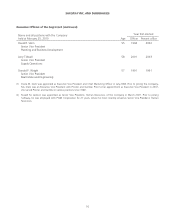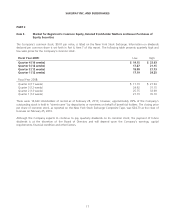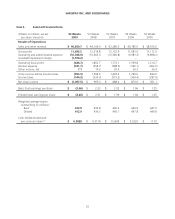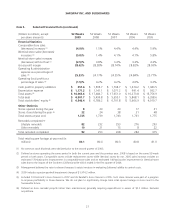Safeway 2009 Annual Report Download - page 30
Download and view the complete annual report
Please find page 30 of the 2009 Safeway annual report below. You can navigate through the pages in the report by either clicking on the pages listed below, or by using the keyword search tool below to find specific information within the annual report.SAFEWAY INC. AND SUBSIDIARIES
acquisitions, development efforts and other general corporate purposes; (ii) our flexibility in planning for, or reacting to,
changes in our business may be limited; (iii) we might be placed at a competitive disadvantage relative to our competitors
that have less debt; and (iv) we may be limited by the financial and other restrictive covenants in the documents
governing our indebtedness. Changes in our credit ratings may have an adverse impact on our financing costs and
structure in future periods, such as higher interest costs on future financings and our ability to participate in the
commercial paper market. Additionally, interest expense could be materially and adversely affected by increases in interest
rates, increases in the amount of outstanding debt, decisions to incur premiums on the early redemption of debt and any
other factor that results in an increase in debt.
Retirement Plans We maintain defined benefit retirement plans for substantially all employees not participating in
multi-employer pension plans. The funded status of these plans (the difference between the fair value of the plan assets
and the projected benefit obligation) is a significant factor in determining annual pension expense as well as cash
contributions to fund the plans. Historically, Safeway’s retirement plans have been well funded, and cash contributions to
the plans have been relatively small. For example, cash contributions were $16.7 million and $33.8 million in 2009 and
2008, respectively, and were limited primarily to our Canadian retirement plans.
The decline in the financial markets during 2008 resulted in a substantial reduction in the fair value of the retirement plan
assets. As a result, at the end of fiscal 2008, projected benefit obligations exceeded the fair value of plan assets for all of
the Company’s pension plans. In 2009, the financial markets improved. As a result, pension expense in 2010 is expected
to decline compared to 2009. Despite the improvement in the financial markets at the end of 2009, the projected benefit
obligation continued to exceed the fair value of the plan assets. The Company currently expects to contribute
approximately $7.8 million to its defined benefit pension plan trusts in 2010, primarily in Canada. If financial markets do
not continue to improve or if financial markets decline, increased pension expense and cash contributions may have an
adverse impact on our financial results.
In addition, we participate in various multi-employer pension plans for substantially all employees represented by unions.
We are required to make contributions to these plans in amounts established under collective bargaining agreements.
Under the Pension Protection Act of 2006 (“PPA”), additional contributions may be required in the form of a surcharge
that is equal to 5% of the contributions due in the first year and 10% each year thereafter until the applicable bargaining
agreement expires. If surcharges are required, many of our bargaining agreements provide for an offset against
contribution amounts otherwise required under those agreements.
Pension expense for these plans is recognized as contributions are made. Benefits generally are based on a fixed amount
for each year of service. We contributed $278.1 million, $286.9 million and $270.1 million to these plans in 2009, 2008
and 2007, respectively. Based on the most recent information available to us, we believe a number of these multi-
employer plans are underfunded. As a result, contributions to these plans may increase. The amount of any increase or
decrease in our required contributions to these multi-employer pension plans will depend upon the outcome of collective
bargaining, actions taken by trustees who manage the plans, government regulations, the actual return on assets held in
the plans and the potential payment of a withdrawal liability if we choose to exit a market, among other factors.
Additionally, the benefit levels and related issues will continue to create collective bargaining challenges. Under current
law, an employer that withdraws or partially withdraws from a multi-employer pension plan may incur withdrawal liability
to the plan, which represents the portion of the plan’s underfunding that is allocable to the withdrawing employer under
very complex actuarial and allocation rules. Multi-employer pension legislation passed in 2006 and 2008 will continue to
impact the funds in which we participate, which may have an impact on future pension contributions.
Legal Proceedings From time to time, we are a party to legal proceedings, including matters involving personnel and
employment issues, personal injury, antitrust claims and other proceedings arising in the ordinary course of business. In
addition, there is an increasing number of cases being filed against companies generally, which contain class-action
allegations under federal and state wage and hour laws. We estimate our exposure to these legal proceedings and
establish reserves for the estimated liabilities. Assessing and predicting the outcome of these matters involves substantial
uncertainties. Although not currently anticipated by management, unexpected outcomes in these legal proceedings, or
changes in management’s evaluations or predictions, could have a material adverse impact on our financial results.
12


